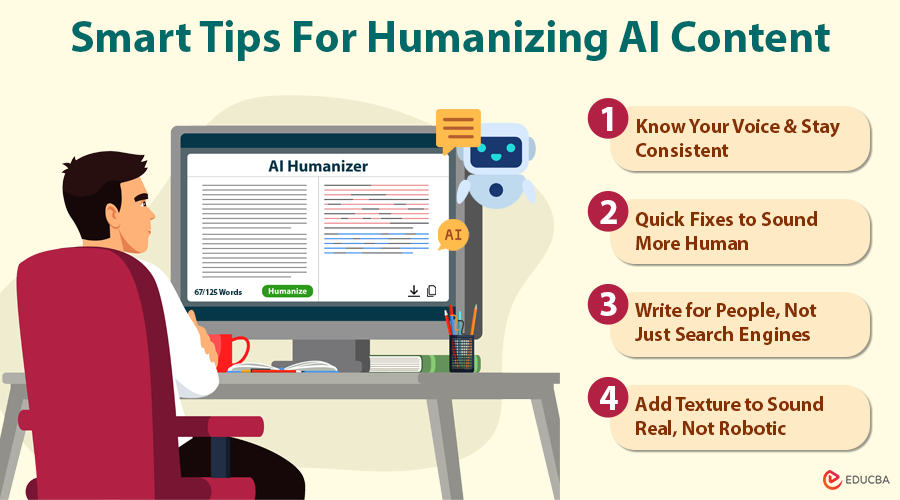
Humanizing AI Content: Overview
AI-written articles often promise fresh insights but can feel robotic, dry, and lacking personality. In a world filled with online content, readers can quickly tell the difference between genuine writing and filler. They want information that not only educates but also feels real and human. That is where humanizing AI content becomes essential.
Adding a human touch helps build trust, keeps your audience engaged, and turns basic writing into meaningful conversations. This article will explore simple techniques to humanize your AI content for warmth and authenticity.
6 Smart Tips For Humanizing AI Content
Want your AI-written text to feel more natural and engaging? These tips will help you add a human touch to your content without starting from scratch.
#1. Know Your Voice and Stay Consistent
Decide on your personal voice. Is it smart and witty? Or calm and instructive? AI usually plays it safe when drafting content, keeping it vague, neutral, and a little lifeless. It depends on how you blend creativity and add your touch. Read the draft and consider whether the audience will resonate. If not, change stiff phrases into more natural ones.
Example:
- AI-generated: “It is essential to maintain a balanced diet.”
- Humanized version: “Your body thrives on balance—nourish it with food that supports your rhythm.”
Adding warmth and personality makes a big difference when humanizing content.
#2. Quick Fixes to Sound More Human
Humanizing content does not always require a complete rewrite if you are using a good AI humanizer. Often, a few thoughtful changes can make all the difference. Try these:
- Start with a hook: Ask a question or share a relatable moment.
- Cut the jargon: Make it simple and clear.
- Use contractions: Say “you’re” instead of “you are.”
- Add real-life examples: People remember stories more than facts.
- Address your reader directly: Use the “you” pronoun and ask questions.
- Vary sentence length: Mix short, punchy lines with longer ones for rhythm.
These tricks help with humanizing content quickly and naturally.
#3. Write for People, Not Just Search Engines
Your audience will quickly become disinterested if your content seems to have been created specifically for Google. Good content strikes a balance between the algorithm and the reader, respecting the algorithm without sacrificing the reader’s experience. Write content that feels like it is carefully written, not churned out by a machine to rank.
| SEO-Driven Content | Humanized Content |
| Keyword-heavy, repetitive phrasing | Natural flow with smart keyword use |
| Generic introductions and conclusions | Engaging openings and thoughtful wrap-ups |
| Overuse of passive voice | Active voice and personal pronouns |
| Focused on volume | Focused on value and story |
Remember, AI can help with SEO, but humanizing content ensures it resonates with readers.
#4. Add Texture to Sound Real, Not Robotic
AI-generated text often feels too perfect, which can make it sound impersonal. Do not be afraid to add a little texture to humanize content. Share a personal anecdote, a funny story, or a relatable struggle. This adds warmth and authenticity.
For example:
- Instead of simply stating, “I’ve tried every to-do app out there.”
- You could say, “I’ve tried every to-do app out there. One even congratulated me with confetti for drinking water. I still missed three deadlines.”
This touch of honesty creates a connection with the reader.
#5. Use Storytelling as a Tool
Storytelling is a powerful way to humanize AI content. While AI tends to present facts in a dry, transactional manner, storytelling adds context, emotion, and meaning to these facts. You make the content more engaging and memorable by weaving facts into a narrative.
For example, rather than simply listing product features, share a story that illustrates how a customer successfully used the product to overcome a challenge or achieve a goal. Client testimonials, personal lessons, or even failures can humanize the content and build trust with the audience.
#6. Final Checklist to Keep Your Content Human
Run your content through this quick gut check before hitting publish to ensure it truly feels human:
- Would I say this out loud?
- Does this content address a genuine issue?
- Is there a clear structure with variety (headings, lists, examples)?
- Have I trimmed the fluff?
- Does it feel like I am talking to someone, rather than lecturing?
- Is there a moment that makes the reader nod, smile, or feel seen?
This quick gut-check helps you ensure your AI content feels human and genuine.
Final Thoughts
AI is an incredible tool, but often falls short regarding emotional connection and authenticity. Following these simple steps to humanize your AI content, you can ensure it resonates with readers and builds trust. With a little creativity and attention to tone, AI-generated content can become relatable, engaging, and, most importantly, human. The key is to infuse your content with warmth and empathy, transforming it from something mechanical into something readers can connect with on a personal level.
Humanizing AI content not only improves engagement but also helps build loyalty, turning a simple article into something readers will feel and remember. So, next time you work with AI, remember to add your personal touch, because the best content always sounds human.
Recommended Articles
We hope this article on humanizing AI content helps you create more relatable and engaging digital experiences. Explore these recommended articles for further tips on blending technology with a human touch in your content strategy.

